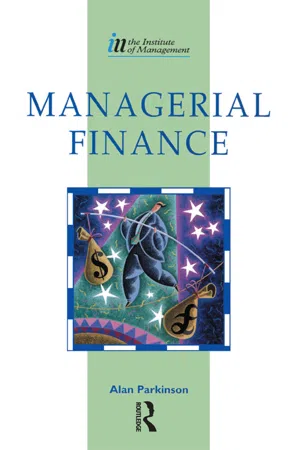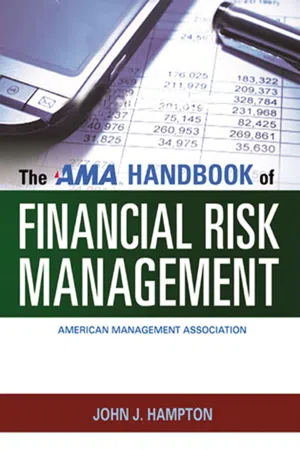Business
Capital Investments
Capital investments refer to the funds allocated by a company for the purchase, improvement, or maintenance of long-term assets such as property, equipment, or technology. These investments are made with the expectation of generating future returns and are crucial for the growth and sustainability of a business. Proper evaluation and strategic allocation of capital investments are essential for maximizing profitability and competitiveness.
Written by Perlego with AI-assistance
Related key terms
9 Key excerpts on "Capital Investments"
- eBook - ePub
- D. Crowther(Author)
- 2007(Publication Date)
- Routledge(Publisher)
All businesses need to incur capital expenditure at some time, whether it is a small plumber buying a new van, a manufacturer purchasing new equipment, or a retailer building a new hypermarket. Capital investment in a business is essential both to replace existing assets as they become worn out (and fully depreciated) and to provide additional assets in order to improve the performance of the business. This improved performance can be in terms of reduced costs of production, increased quality, increased output or changes in the product mix. It is important therefore that capital expenditure proposals are considered in the context of the objectives of the organisation and its long-term plan in order to ensure that any proposed expenditure helps the business to achieve its objectives.Whatever the size of a business capital investment will represent significant activity by the business and will involve committing a significant proportion of the resources of the business to the investment. It is also likely that the investment, once committed to, will be irreversible, or at least the costs of changing the decision will be substantial. As each investment decision is so important to the business in terms of the resources involved, making capital investment decisions is very important to the business and a detailed analysis of costs and benefits is needed before a decision is made. Although each such decision is an individual decision, and made on its own merits, the consequences of the decision can impact upon the business in areas other than those with which the investment is concerned.We have seen previously that a business operates in an environment of scarce resources and that there are competing uses for those resources. This is equally true of the resources available for capital investment and a business is likely to have a variety of proposals for capital expenditure, all of which will improve the performance of the business. The available resources, however, are unlikely to be sufficient to undertake all possible investments which will improve performance, and so some form of selection is needed in order to decide which to undertake and which to defer or cancel. One effect of a capital expenditure decision therefore is that it excludes the possibility of undertaking alternative investments. - eBook - ePub
Return on Investment Manual
Tools and Applications for Managing Financial Results
- Robert Rachlin(Author)
- 2019(Publication Date)
- Routledge(Publisher)
19Capital Investments—The Key to Higher Profits, Cash Flows, and Return on Investment
It is an accepted fact in business that Capital Investments are a key element of a company’s long-term growth. Why are they so important? They provide a continuous flow of future profits and cash needed for operating and investment decisions.It must be also recognized that all products and services have a life cycle, at the end of which they will no longer appeal to the marketplace and will be replaced by other forms of products or services. Although people generally associate life cycles with products, services have them also. Just look at bank services offered ten years ago and those being offered today. Therefore, in every business, new products and services must be provided to replace technology, to meet changing population trends, to meet obsolescence, to meet economic changes, and to meet changing end-user demands.This chapter discusses the vital role top management plays in capital investment decisions, the classifications and process of Capital Investments, the methods of financing, and an example illustrating how debt can reduce the average weighted cost of capital. Chapter 20 provides the step-by-step methods for calculating and evaluating Capital Investments and concludes with examples of actual firms’ capital investment policies and procedures.Why Capital Investments Are Important
Decisions on Capital Investments are extremely important to the continuous success of the company, and therefore top management usually assumes direct responsibility for the larger and more important expenditures. Because of the nature and substantial amounts of the expenditures, these capital investment decisions are important and deserve the attention of top management for the following reasons.Substantial Amounts of Money
Most expenditures that are governed by the policies of the capital expenditures program involve substantial amounts of money. It is money invested not only in fixed assets but also in the working capital of the company. Since one of the main functions of top managers is to manage the assets and resources of the company, capital investment decisions are their responsibility. - Michael Chibili(Author)
- 2019(Publication Date)
- Routledge(Publisher)
15Capital investment decisions
15.1 Types of capital budgeting decisions15.2 Basic methods for making investment decisions15.3 Simple and compound interest15.4 Process of discounting15.5 Understanding factor tables15.6 Discounted cash flow (DCF) methods15.7 Incidence of taxes on DCF analysis15.8 Choosing between projectsBusinesses are created with the aim of existing forever. For this to become possible, the business must be able to earn profits over a period of years. In this case, short term gains might have to be sacrificed in the interest of long term goals. Decisions that involve the acquisition of equipment, land, buildings, and vehicles are examples of decisions that businesses will periodically have to make that have an influence on their cash flows. In the hospitality industry, the largest investments that are normally made will be about land or building acquisition. However these are not decisions that are made on a day-to-day basis. Whether the opportunity involves building a new hotel, modernizing an old one, or extending a hotel, money must be made available and spent on what might be called a ‘capital investment’ that is expenditure incurred now in order to produce a stream of benefits over a period of years which will, it is hoped, result in the firm being in a more favourable position. Capital investment decisions differ from operating decisions by reason of the nature of the expenditure and the length of time before the full effect of the decision is felt.- eBook - ePub
- Alan Parkinson(Author)
- 2012(Publication Date)
- Routledge(Publisher)
The significance of the capital investment decision is thus clear. The reasons rationalizing the significance apply to longer term investment decisions in general although their degree of significance, and thus their degree of influence upon decision-making, will vary according to the particular type of decision and organizational activity being looked at. A common feature that all capital budgeting decisions have with shorter term investments is that managers are looking at making investments which will (hopefully!) produce returns. The distinction is that the longer term investment decision will produce returns over a number of future time periods rather than the current period returns which arise from other types of decisions.Capital investment decisions will generally be concerned with the planning for and management of activities such as:- the acquisition of fixed assets such as land and buildings, plant and equipment and vehicles (be it a first-time or replacement acquisition)
- investment in a special project such as a marketing/advertising campaign or research and development
- the expansion of current facilities, be they production or administrative or in relation to any other
- entry into new product/service provision
- investment in development of managers, such as yourself, through training and education.
Such investment decisions are never easy Often, given the long-term nature of the decision consequences, the projected outcomes and associated returns are at best uncertain and at worst unpredictable and/ or intangible. Given this scenario it is understandable that many managers seek advice from all quarters as an aid to reducing the risk of making the wrong capital investment decisions. What they invariably seek is a framework, at least from a financial angle.A framework for predicting the future
If you as a manager had the opportunity to design an appropriate advisory framework from scratch, it is likely that you would wish the design to help you to solve certain key problems which might hamper your effective decision-making. Perhaps the two key problems needing remedies might be: - eBook - ePub
- Roland Gareis, Lorenz Gareis(Authors)
- 2018(Publication Date)
- Taylor & Francis(Publisher)
Investments may relate to various objects—namely, to a product or service, a market, the organization, the personnel, the infrastructure, the financing, and a stakeholder relation. Therefore, unlike in accounting, the definition of an investment used here is not limited to depreciable fixed assets.Definition: InvestmentAn investment is defined as a chain of business processes required to ensure an organization’s capacity to provide services. A differentiation may be made between product or service-related investments, market-related, organization-related, personnel-related, infrastructure-related, financing-related, and stakeholder-related investments.Investment Types
In accordance with the structural and contextual dimensions of organizations defined above, investment types can be differentiated as follows:- product or service-related investments (e.g., developing and selling a product),
- market-related investments (e.g., developing and serving a market),
- organization-related investments (e.g., developing and using an organization),
- personnel-related investments (e.g., developing and deploying personnel),
- infrastructure-related investments (e.g., developing and operating ICT infrastructure),
- finance-related investments (e.g., an initial public offering), and
- stakeholder-related investments (e.g., developing and using a supplier relation).
The general life cycle of an investment object includes the phases of planning, implementing, operating or using, and any subsequent decommissioning of an investment object. The life cycle of an investment object begins once the investment decision is taken. The life cycle of an industrial plant, for example, includes the following chain of business processes: “constructing the industrial plant”, “operating the industrial plant”, “maintaining the industrial plant”, and “decommissioning the industrial plant”. The upstream business process “conceptualizing the industrial plant investment” provides a temporal context for this investment.Fig. 3.4 - eBook - ePub
- Kristin L. Reiter, Paula H. Song(Authors)
- 2020(Publication Date)
- AUPHA/HAP Book(Publisher)
PARTVIPART VI, CAPITAL INVESTMENT DECISIONS
I n part V, we focused on capital acquisition (long-term financing), including capital structure decisions and cost-of-capital estimation—in other words, how businesses raise the funds to buy needed land, buildings, and equipment and how they estimate the cost of those funds. In part VI, we turn our attention to the capital investment decision, focusing on how those funds can be deployed (spent) in the most financially efficient manner.Our discussion of capital investment decisions spans two chapters. The most critical part of the decision process involves cash flow estimation, because the financial attractiveness of proposed projects stems solely from the cash flows they are expected to produce. Chapter 14 covers the basic concepts of capital investment analysis, including how to estimate a project’s cash flows and how to measure its expected financial impact. In addition to cash flow estimation, risk is an important consideration in capital budgeting. Chapter 15 explains how to assess the risk of a project and incorporate that assessment into the capital investment decision process.Passage contains an image
CHAPTER 14CHAPTER 14, THE BASICS OF CAPITAL BUDGETING
Learning Objectives
After studying this chapter, readers will be able to- Explain how managers use project classifications and post-audits in the capital budgeting process.
- Discuss the role of financial analysis in health services capital budgeting decisions.
- Explain the key issues involved in cash flow estimation.
- Describe the usefulness and methods applied in breakeven and profitability analyses.
- Conduct basic capital budgeting analyses.
Introduction
This chapter focuses on long-term (fixed) asset acquisition decisions, which involve the expenditure of capital funds. Such decisions commonly are called capital budgeting decisions because the listing of all Capital Investments (projects) to be undertaken in the future is known as the capital budget - eBook - ePub
- John Hampton(Author)
- 2011(Publication Date)
- AMACOM(Publisher)
Substantial dollar amounts . These investments are generally made in large projects involving tens or even hundreds of millions of dollars. In terms of dollars alone, capital budgeting decisions are significant to even the largest corporations.• Long time periods . When financial securities are purchased, a decision that is made today can easily be reversed tomorrow. Stock bought on an exchange can be sold, reversing the transaction. This is not the case with the purchase of capital assets. The company is making a long-term decision that is not likely to be reversed in a short period of time.• Loss of liquidity . Money invested in capital assets is not readily available for other purposes. The loss of liquidity adds to the significance of capital budgeting activities.• Over- and undercapacity . If the budget is drawn carefully, it usually improves the timing and quality of asset acquisitions. If it is done poorly, it can cost the firm large sums of money because it leads to overcapacity or undercapacity, sometimes at the same time. The firm may have idle assets to produce a product that is not in demand, but also have a shortage of the machinery and facilities needed to produce a much-demanded, high-profit product.Motives for Investment
A corporation evaluates capital budgeting proposals for several reasons, including:• High profits . Capital Investments offer the prospect of high risk and high return. One motive for investing is to earn a high profit.• Growth . By purchasing capital assets that offer potentially high returns, a corporation can accelerate its growth.• Diversification . Many companies operate in cyclical businesses. A company can reduce the risk of large losses in one area by acquiring other lines of business.Ranking of Proposals
Once the capital budget is nearing completion and different projects have been identified, the firm must select the projects it will finance. Among the problems that arise are the following:• Mutually exclusive projects . If the firm accepts one project, it may rule out another. These are called mutually exclusive projects - eBook - ePub
Financial Management
An Introduction
- Jim McMenamin(Author)
- 2002(Publication Date)
- Routledge(Publisher)
Many of these expenditures possess the characteristics of investment in fixed assets. They involve very substantial outlays, have long-term payoffs, and are vitally important for the survival and growth of a competitive firm. However, from a traditional financial accounting perspective, expenditures of this nature are not viewed as capital investment. They are instead treated as revenue expenditures and are charged against profits as they are incurred.While investment decisions of this nature do not add to the stock of real corporate assets, they are nonetheless vitally important to the firm's long-term survival and growth. Therefore it is our contention that they should be subject to the same type of rigorous investment appraisal process.Mandatory and discretionary investments
Some Capital Investments will be mandatory ; that is, management will have no choice but to undertake the investment (e.g. to comply with health and safety and other legislation or to stay up with the competition) in order to remain in business. Other investments can be categorised as discretionary - eBook - ePub
- Cheryl S. McWatters, Jerold L. Zimmerman(Authors)
- 2015(Publication Date)
- Routledge(Publisher)
The size and strategic implications of a long-term investment decision make those decisions much more critical to the organization. Therefore, organizations carefully control the decision process for these investments. We describe the control aspects of the long-term investment decision later in the chapter.The multi-year, cash-flow implications of a long-term investment decision introduce additional complications in comparing the decision’s costs and benefits. Cash flows received or paid in different years are not directly comparable. The remainder of this chapter and the Appendix describe procedures to adjust the costs and benefits from different time periods to make them comparable.The Capital-Budgeting ProcessCapital budgetingis a process of evaluating and choosing long-term investments. Given the size of long-term investments, the organization should take extra care in making these decisions. Typically, the capital-budgeting process includes: (1) initiation or identification of the investment proposal, (2) ratification, (3) implementation, and (4) monitoring. These are the same decision-making steps described in Chapter 5 . While we describe this process for one investment opportunity, organizations frequently make these decisions in conjunction with other decisions that compete for organizational resources. Several capital-budgeting projects may be evaluated simultaneously; each project might have different time horizons, costs, risks, and trade-offs. The capital-budgeting process considers how each proposed project fits with the organization’s strategic focus in the short and long term.1The initiation process begins with the identification of possible investment opportunities. Different members of the organization can make proposals, but usually individuals with the most information initiate investment proposals. These proposals include a description of the investment opportunity and the predicted effect of the investment on cash flows. Large investment proposals often include the predicted impact on the balance sheet and profit and loss (income) statement. Initiation is a planning process.
Index pages curate the most relevant extracts from our library of academic textbooks. They’ve been created using an in-house natural language model (NLM), each adding context and meaning to key research topics.








